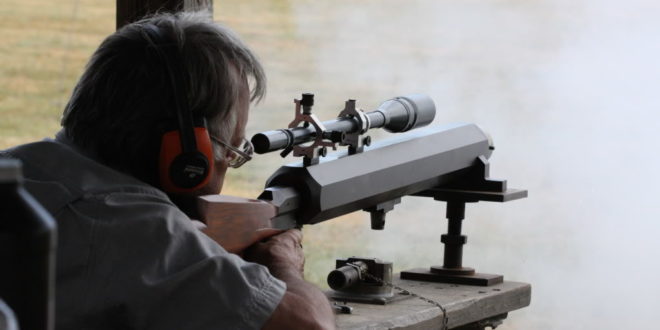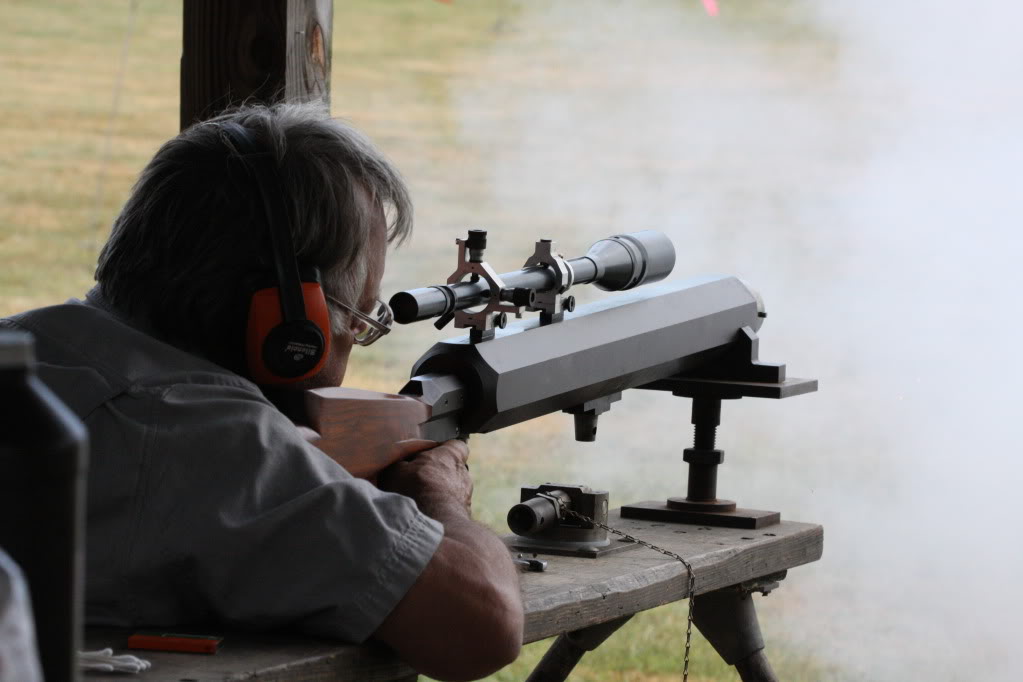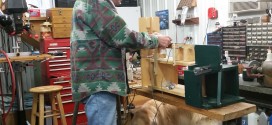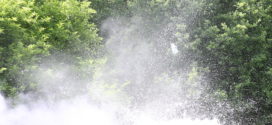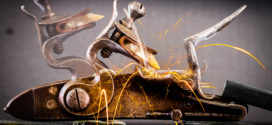Blackpowdermag editor, Larry Pletcher
For years I’ve been fascinated with the slug guns during the Muzzleloading Championships at Friendship. This year I decided to do an article on these remarkable guns. This article is the first in a two part series on slug guns. The second will look at the largest slug gun I have ever seen.
Slug gun shooting has a long tradition in the NMLRA. During my 30+ years of trips to Friendship, visits to the slug gun range have been a part of my plans. This year I decided to write up my experiences
The slug gun is unique among the various types of blackpowder guns. The typical muzzleloading slug gun is heavy often 30-40 pounds. The largest known slug guns exceed 100 pounds. One of these amazing guns was shot this year. The barrels are large diameter, shorter than round ball bench gun barrels, but do use a false muzzle. The actions are the underhammer variety with sealed ignitions. (Sealed ignitions completely enclose the cap, preventing gases from escaping the barrel at the nipple.)
Typical barrels are rifled for a .45 bullet with a 1 turn in 18” twist. Other calibers are seen at Friendship from .40s to the huge .69 caliber that appeared this year. Mounted on the barrel is a target quality telescopic sight. These vary in power; 24x seems to be the optimum for this type of shooting. (Higher powers tend to have greater problems with mirage.) Scope adjustments are in the mounts.
The typical .45 caliber bullet weighs 550 grains while the .69 caliber bullet weighed more than three times as much. The bullet is normally swaged from two pieces – a harder nose swaged to a softer base. This prevents the nose from deforming but allows the base to bump up into the rifling. Many shooters design their own bullets, casting their own cores, and swaging the complete bullet. A typical bullet design would use three calibers as the length.
The bullet is wrapped in a paper patch. Most shooters use the cross patch method. Narrow strips of paper are positioned on the false muzzle, the bullet placed on top, and the bullet carefully seated with a mechanical seating tool. The seating device may be a plunger whose nose is machined to fit the nose of the bullet. Another device uses levers to provide mechanical advantage.
Every trick is used to produce the smallest groups. Even though bullets are swaged, they are culled very close tolerances. Powder is pre-weighed. I saw one shooter with an enclosed weighing and charging station, designed to prevent a breeze from changing the delicate scale’s reading.
Shooting a slug gun involves many skills, among those is the ability to handle the wind. The ability to read wind flags is not unique to slug gun shooting, but shooting paper targets at 500 yards requires a shooter to develop these skills. That being said, George Mitchell, who shoots the 100 pound, .69 caliber gun, said he didn’t worry about wind too much. He probably does, but his huge, 1785 grain, bullet does have wind-bucking abilities.
I found the slug gun shooters a helpful group when I gathered information for this article. I was careful to wait for relays to end before asking questions. I was allowed access to take pictures and to develop the loading sequences shone in the photos. All were free with details about their guns, scopes, loading equipment, and bullets.
The guns, equipment, and the shooters make slug gun shooting a truly unique experience at Friendship. Take the time to visit the slug gun range. Part 2 of this Slug Gun series will zero in on the largest gun at Friendship this fall. The photo below, I hope will whet your appetite.
 BlackPowderMag.com Flintlock Rifles and Black Powder Guns
BlackPowderMag.com Flintlock Rifles and Black Powder Guns
